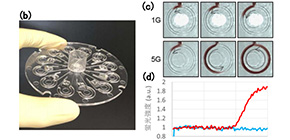
Easy and quick gene detection method μOCEAN will provide a broad range of applications
A group of researchers from Osaka University invented a method to control thermal convection speed by utilizing centrifugal force, improving the Polymerase Chain Reaction (PCR) reaction time and achieving quick DNA amplification in a ring-structured microchannel. Using this method, they developed a quick DNA amplification system named μOCEAN (micro Orbitual Chip for Easy Amplification of Nucleic Acid) in cooperation with Konica Minolta Business Innovation Center (BIC), Japan.
PCR, an amplification technique for cloning specific or targeted parts of a DNA sequence to generate thousands to millions of copies of DNA of interest, is used in molecular biology, a variety of tests for identifying disease pathogens, and cell mutations that can cause a wide range of disorders. However, it required complicated sample preparations, a trained, skilled technician, and PCR facilities, and even the process from preparation through analysis of a solution of 25µL (half teardrop) containing DNA took about 2 hours.
This group worked to develop a technique to comprehensively solve challenges in the practical use of PCR, using the Micro-Total Analysis System (µ-TAS) technique. µ-TAS are liquid handling circuit devices (microfluidics), also known as ‘lab on a chip’ devices, in which all necessary parts to perform a chemical analysis are integrated on a substrate. Their inherent small microfluidic systems allow for quick thermal exchange, prevention of molecular diffusion, and reduced reagent usage.
Using a ring-shaped microchannel and a heater stage and controlling the flow dynamics by changing the stage rotation speed, they demonstrated the success of a method to generate thermal convection, examining the application of this method to PCR. In their method, continuous thermal exchange and DNA amplification are performed while the DNA sample solution is mixed in the microchannel, which reduced DNA amplification reaction time, allowing for quick gene detection. With this method, DNA amplification of β- actin DNA of 120 pg was performed within 10 minutes.
Because this method allows one to supply an appropriate amount of the PCR solution into the microchannel using a combination of the capillary effect and centrifugal force, even individuals without skills can perform PCR. Additionally, using this method, this group developed a quick and easy DNA detection system μOCEAN, in joint research with Konica Minolta BIC, Japan.
Their achievements will increase the ease of use of gene detection in on-site utility, allowing for quick detection of microbial resistant bacteria, lactic acid bacteria (such as intestinal flora), and food poisoning bacteria. This technique will be applied in a various areas, including medical diagnosis, health management, food safety, agriculture, and livestock raising.
Figure 1
The article “Centrifugation controlled thermal convection and its application to rapid microfluidic PCR devices,” was published in ACS Publications at DOI: https://doi.org/10.1021/acs.analchem.7b03107 .
Related links
